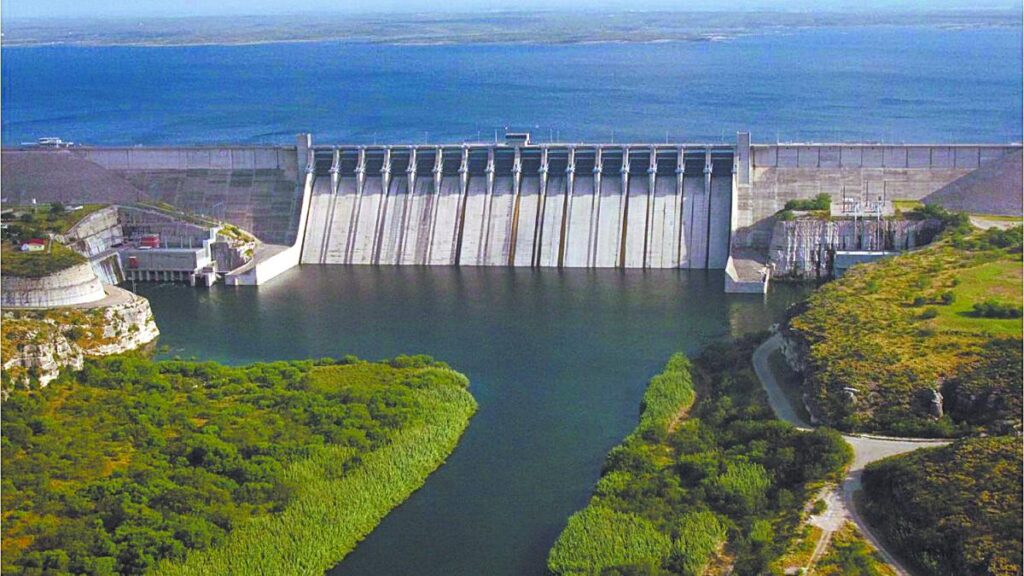Introduction to the Rio Bravo Basin and its Dams
The Rio Bravo basin, spanning across five northern Mexican states (Chihuahua, Coahuila, Nuevo León, Tamaulipas, and Durango), consists of 22 dams: two international ones managed by Mexico and the United States, and 20 national dams. Recent data from Mexico’s National Water Commission (CONAGUA) reveals concerning trends in the storage levels of these dams, particularly for the international dams: La Amistad and Falcón.
International Dams: La Amistad and Falcón
The Falcón dam, located in Tamaulipas, reported a mere 8% storage level in April 2025, with an accumulated volume of 112,788 hectares cubic meters (hm³). This figure represents a drastic drop from 36% in 2024 (487,656 hm³) and 70% in 2020 (205,545 hm³). The storage level has decreased by 28 percentage points in a year and 62 percentage points over five years.
La Amistad, situated in Coahuila, reported a 14% storage level in 2025 (241,288 hm³), slightly above the 11% in 2024 (192,326 hm³) but 12 percentage points higher than the 2% in 2020 (23,851 hm³). Although there is a recovery compared to 2020, the storage remains far from optimal conditions.
Historical Context and Capacity of the Dams
Built between 1950 and 1954, the Falcón dam spans 8,014 meters (4,926 meters in Mexico and 3,088 in the United States), reaching a height of 50 meters and capable of storing up to 4,862 billion cubic meters (mm³) at its extraordinary maximum level (NAME). The ordinary maximum level (NAMO) allows for a storage of 3,264.8 mm³, with 41.1% allocated to Mexico and 58.6% to the United States.
La Amistad, initiated in 1965 and completed in 1969, is a mixed engineering feat (concrete, earth, and rock) located near Acuña, Coahuila. Its dam extends 9,815 meters (6,560 meters in Mexico and 2,590 in the United States) over the Rio Bravo course and can hold up to 36,258 hectares at its extraordinary maximum. The total storage capacity at NAME is 6,683.2 mm³, while NAMO allows for 4,040.3 mm³.
Storage Levels Across the Basin
An analysis of official figures shows that 13 out of the 22 dams in the basin experienced reductions in storage levels compared to 2024, while only seven dams showed increases.
Chihuahua, with the most storage infrastructure in the basin, has been severely impacted by drought. The state’s dams collectively store 687,864 hm³ of water in 2025, a substantial decrease from the 1,325,853 hm³ in 2024.
- The Boquilla: From 899,164 hm³ (32%) in 2024 to 417,689 hm³ (15%) in 2025.
- Las Vírgenes: From 101,140 hm³ (30%) to 38,889 hm³ (12%).
- El Rejón: From 5,685 hm³ (87%) to 1,993 hm³ (31%).
- Pico del Águila and Piedras Azules: Maintained storage levels above 60%.
Coahuila, with five dams, reported a total storage of 467,485 hm³ in 2025, a slight improvement from 402,925 hm³ in 2024. La Amistad and La Fragua showed notable increases, with La Fragua rising from 53% to 95% storage and currently holding 44,696 hm³. However, El Centenario decreased from 66% to 44%.
Nuevo León presents the most optimistic scenario, with its four dams collectively storing 1,393,003 hm³ in 2025—more than triple the 457,316 hm³ in 2024. El Cuchillo, crucial for Monterrey’s supply, increased from 407,863 hm³ (36%) to 1,033,210 hm³ (92%). Cerro Prieto experienced the largest increase, rising from 22,150 hm³ (7%) to 317,647 hm³ (106%). La Boca rose from 38% to 80%.
Tamaulipas, with three dams, saw mixed results. Marte R. Gómez doubled its volume from 385,891 hm³ (49%) to 726,441 hm³ (93%), but Falcón suffered a severe drop. Combined, Tamaulipas holds 867,851 hm³ in 2025, down from 896,900 hm³ in 2024.
Durango, with only the San Gabriel dam, reduced its storage from 103,250 hm³ (42%) in 2024 to 51,060 hm³ (21%) in 2025—a decrease of 21 percentage points.
Key Questions and Answers
- What are the international dams in the Rio Bravo basin? The two international dams are La Amistad (Mexico) and Falcón (Mexico-US).
- Why are the storage levels of these dams concerning? The storage levels have significantly decreased over the past few years, indicating a severe drought in the region.
- What are the capacities of La Amistad and Falcón dams? La Amistad can store up to 6,683.2 billion cubic meters (mm³) at its extraordinary maximum level (NAME), while Falcón can store up to 4,862 mm³ at the same level. The ordinary maximum levels (NAMO) are 4,040.3 mm³ for La Amistad and 3,264.8 mm³ for Falcón.
- How do the storage levels compare across different states in the basin? Chihuahua has experienced the most significant decrease, while Nuevo León shows the most optimistic scenario with increased storage levels.






